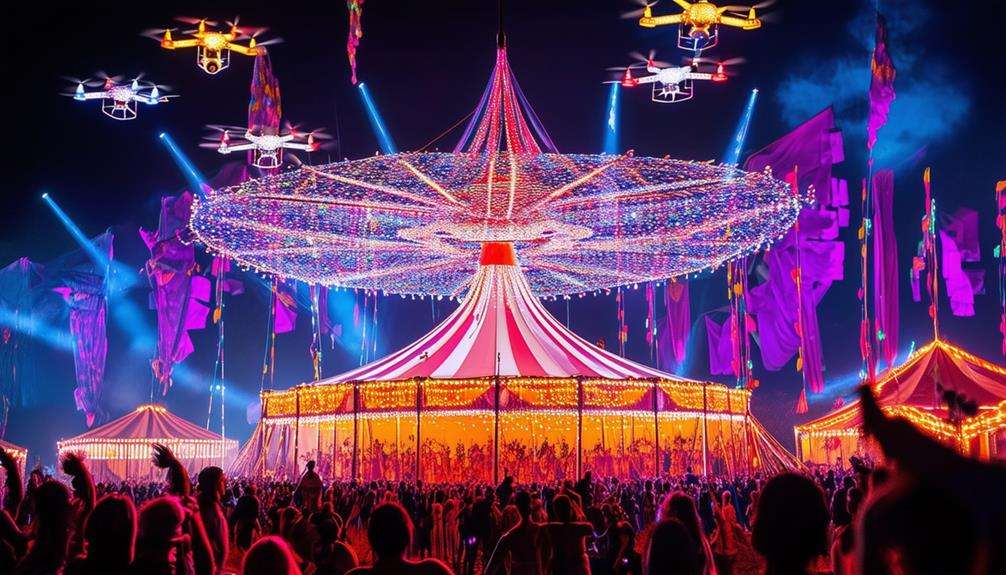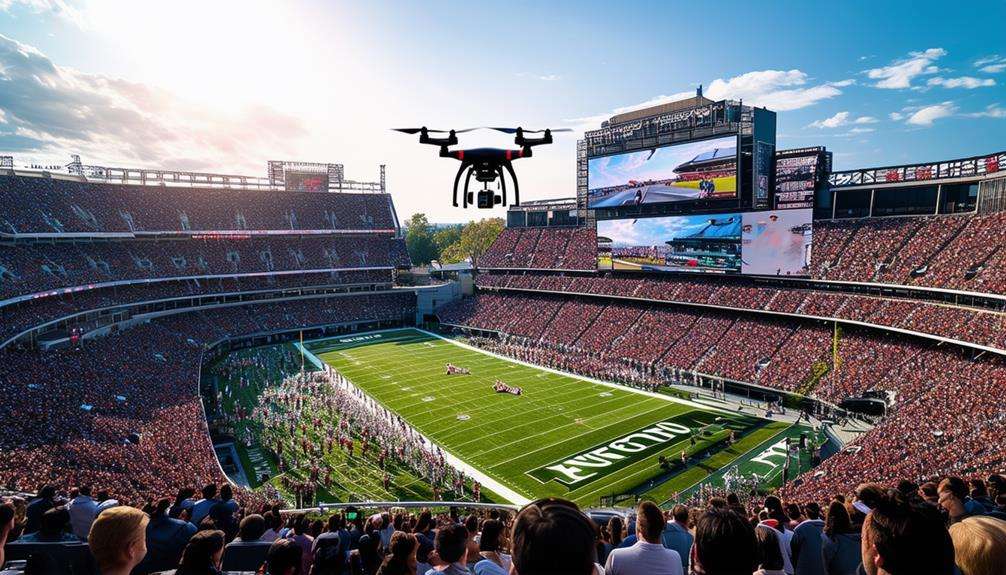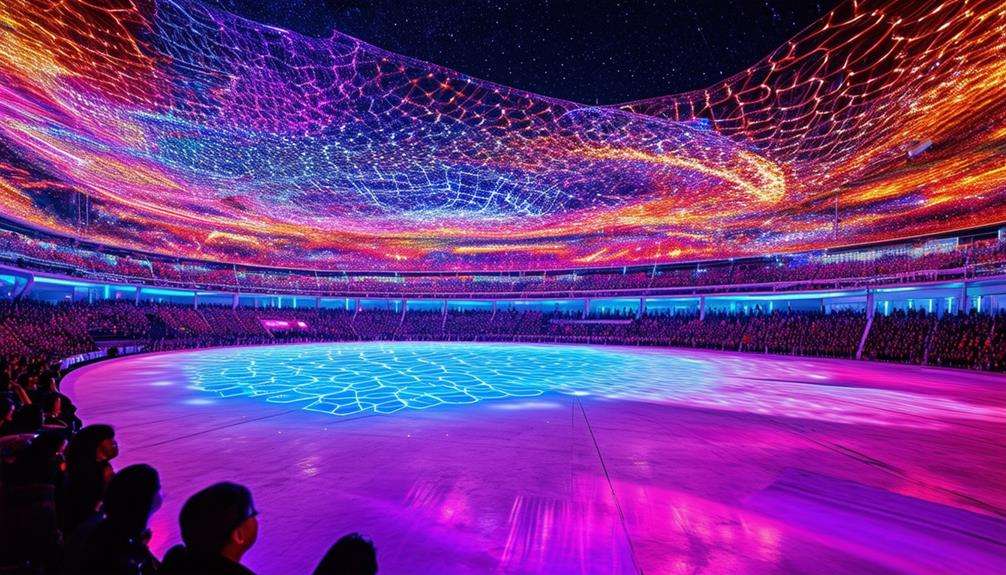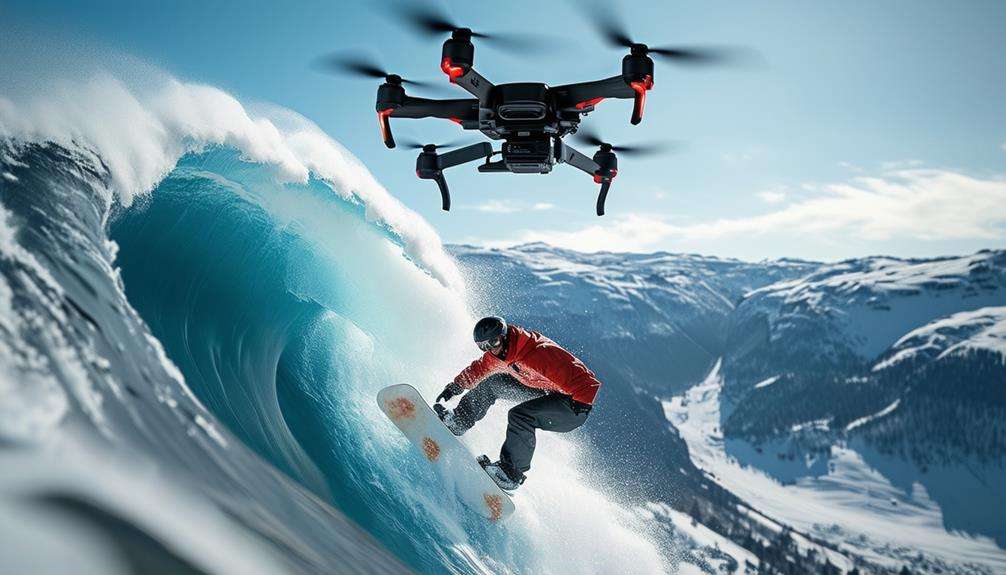Using Drones to Film Scenic Landscapes for Movies
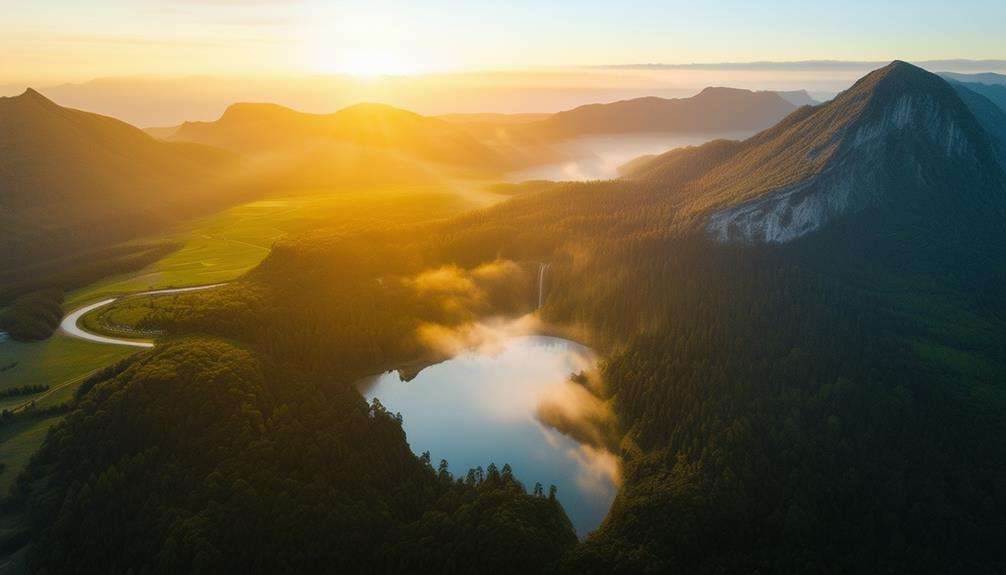
Using drones to film scenic landscapes for movies is an excellent solution for capturing stunning visuals. These versatile tools allow for shots from angles and heights that were once impossible or prohibitively expensive.
Integrating drones not only reduces costs but also enhances storytelling with dynamic, fluid footage. However, specific techniques and challenges must be considered to fully harness their potential. How can you maximize the benefits of drone cinematography while ensuring safety and compliance with legal regulations? Let's explore this further.
Popular Drones for Filming
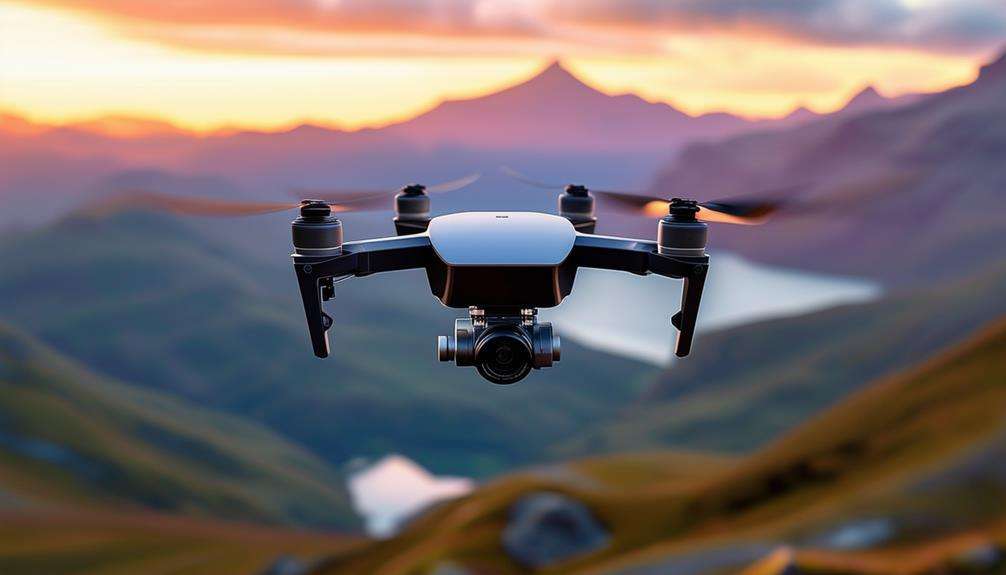
For capturing scenic landscapes with drones, some of the most popular options are the DJI Mavic 2 Pro, DJI Inspire 2, Mavic Air 2, DJI Mavic 3 Cine, and Skydio 2. Each of these drones offers unique features that make them ideal for filmmakers aiming to capture stunning aerial footage.
The DJI Mavic 2 Pro is renowned for its Hasselblad camera with a 20MP 1-inch CMOS sensor, enabling highly detailed shots, perfect for any film project requiring crisp landscape visuals. The DJI Inspire 2 stands out with its Zenmuse X7 camera, capable of shooting in 6K CinemaDNG and 5.2K Apple ProRes, making it a top choice for professional filmmakers seeking high-resolution aerial shots.
If you need longer flight times and high-resolution capabilities, the Mavic Air 2, with its 48MP camera sensor and 34-minute flight time, is an excellent option. The DJI Mavic 3 Cine boasts a 4/3 CMOS sensor and 5.1K video resolution, along with an impressive 46-minute flight time, ideal for extended shoots. Lastly, the Skydio 2 excels with its autonomous flight technology and AI tracking capabilities, allowing you to capture dynamic shots effortlessly.
Benefits of Drone Cinematography
Drone cinematography has revolutionized the way filmmakers capture scenic landscapes by offering cost-effective and flexible solutions. Gone are the days when you needed expensive helicopter support to achieve breathtaking aerial shots. Drones provide a more affordable and versatile alternative, enabling filmmakers to discover unique perspectives and creative possibilities that were previously out of reach.
Advancements in drone technology have enhanced mobility and stability, enriching visual storytelling. Drones allow filmmakers to capture immersive footage that adds depth and visual appeal to their cinematic projects. Whether filming sweeping vistas, rugged coastlines, or dense forests, drones make it easier to showcase the beauty of these landscapes from captivating angles.
Various industries utilize drone cinematography to elevate their visual content. As a filmmaker, you can benefit immensely from this technology. Drones are indispensable tools that bring a new level of creative freedom to your work, allowing you to film dynamic and visually stunning scenes. By leveraging the potential of drone cinematography, you can elevate your films and create unforgettable cinematic experiences.
Essential Techniques
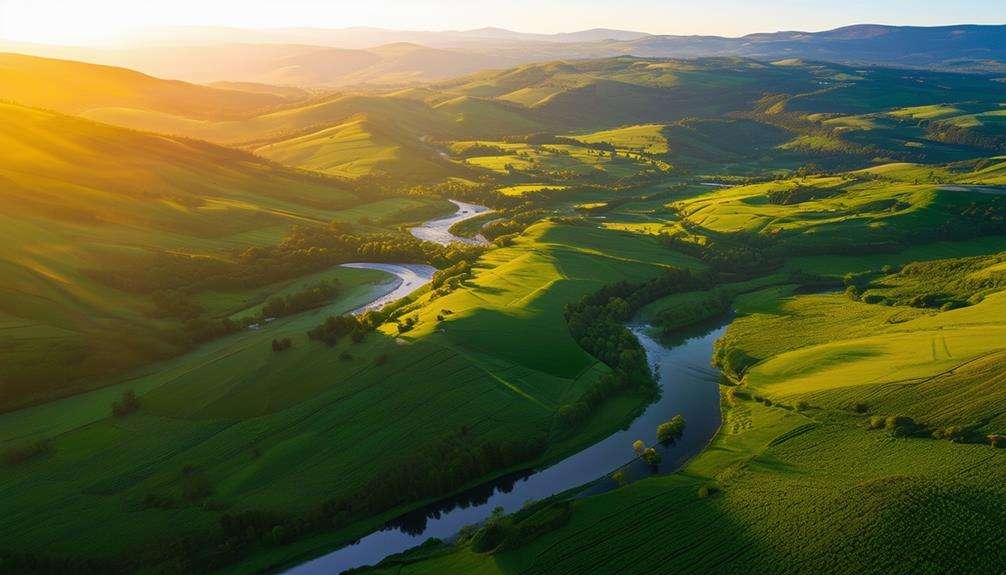
Mastering essential techniques is crucial for capturing stunning drone footage of scenic landscapes. Begin by experimenting with various heights and angles to offer a diverse range of perspectives. Tracking shots are ideal for following a subject through a landscape, adding fluidity and motion to your scenes. Conversely, establishing shots set the stage by providing viewers with a broad view of the environment.
Altitude changes are vital for adding depth and dynamism to your footage. Varying the altitude helps create a sense of scale and grandeur, essential for capturing the majesty of landscapes, as seen in films like The Revenant. Pay close attention to dynamic range to ensure that both highlights and shadows are well-exposed, enhancing the immersive quality of your footage.
Smooth and deliberate camera movements can elevate a simple shot into a cinematic masterpiece. Experiment with unique angles and perspectives to reveal scenes in captivating ways.
Monitor your flight time to maximize your drone's battery life, ensuring you capture all necessary shots efficiently. By employing these techniques, you'll elevate your drone cinematography and craft unforgettable visual stories.
Overcoming Challenges
When filming scenic landscapes with drones, overcoming challenges is crucial. You must navigate weather conditions, ensure legal compliance, and manage battery life effectively.
Each of these factors significantly impacts the quality of your footage and the safety of your crew.
Navigating Weather Conditions
Mastering weather conditions is essential for capturing stunning, high-quality drone footage of scenic landscapes. Drones offer a unique aerial perspective, but weather conditions can significantly impact the quality of your shots. Monitoring weather is a crucial part of maintaining drone stability and optimizing filming schedules.
Here are four key tips to effectively navigate weather conditions:
- Check Weather Forecasts Regularly: Habitually monitor weather updates. Accurate forecasts help you choose the best times for capturing scenic landscapes.
- Manage Wind Conditions: Strong winds can destabilize your drone and degrade image clarity. Avoid flying in high winds and always have a contingency plan for safe landing in changing conditions.
- Protect Against Rain and Moisture: Rain can damage your drone and blur your footage. Use waterproof gear and avoid flying in damp conditions to protect your equipment.
- Consider Temperature Extremes: Extreme temperatures can affect battery life and drone performance. Ensure your drone is rated for the temperatures you'll encounter and carry spare batteries if needed.
Ensuring Legal Compliance
Ensuring legal compliance is crucial for safely and ethically capturing stunning drone footage of scenic landscapes. To begin, make sure you understand and adhere to FAA regulations, including obtaining your Part 107 certification for commercial drone operations. This certification is essential for legally filming landscapes.
Additionally, familiarize yourself with local laws and drone regulations, which can vary significantly from one area to another. When planning to film in protected areas or national parks, securing the necessary permits or authorizations is a must. These areas often have strict rules to preserve their natural beauty and protect wildlife.
Implementing safety measures, such as maintaining a clear line of sight with your drone and avoiding flights over private property without explicit permission, is also critical. Staying informed about evolving drone regulations is vital. Laws can change, and adapting your filming practices accordingly mitigates legal risks.
Managing Battery Life
Effectively managing drone battery life is crucial for capturing uninterrupted, high-quality footage of scenic landscapes. The flight time of a drone battery usually ranges from 20 to 30 minutes, depending on the model and environmental conditions. Factors such as wind speed, temperature, and payload weight can significantly affect battery performance.
To address these challenges, consider the following strategies:
- Carry Multiple Batteries: Always have several fully charged batteries available. This allows you to quickly replace a depleted battery, minimizing downtime during your shoot.
- Monitor Weather Conditions: Adverse weather conditions like high wind speeds and extreme temperatures can drain your drone battery faster. Plan your flights during optimal weather conditions to extend battery life.
- Optimize Payload Weight: Keep your drone as light as possible. Excess weight can decrease flight time, so only bring essential equipment.
- Implement Proper Battery Management: Regularly inspect your batteries for wear and tear, and utilize drones with features like quick battery swaps, such as the DJI Inspire 2. Effective battery management helps prevent sudden power loss and ensures safe operation.
Innovations and Trends
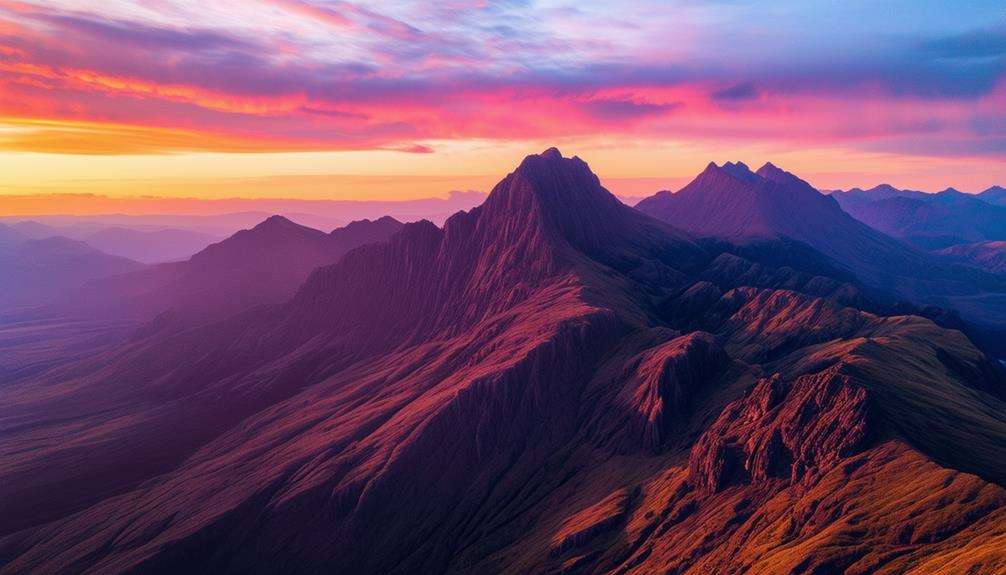
Innovations in drone technology have revolutionized aerial cinematography. This advancement enables the capture of stunning visuals with unprecedented ease and precision. As trends evolve, drones are becoming essential for creating unique and immersive cinematic experiences.
Advanced Drone Technology
Advancements in AI-powered drones and VR/AR integration are revolutionizing drone cinematography, transforming the way we capture and experience scenic landscapes. Leading models like the DJI Inspire 2 and DJI Mavic 3 Cine are at the forefront of this transformation, offering filmmakers advanced camera systems that deliver breathtaking footage and making aerial cinematography more accessible and impressive than ever.
These innovative tools enable you to capture high-quality aerial shots that enhance your visual storytelling. Continuous progress in drone technology offers several key benefits:
- AI-Powered Features: Including obstacle detection and automated flight paths, allowing you to concentrate on capturing the perfect shot without worrying about navigation.
- VR/AR Integration: Enables you to plan and visualize your shots in a virtual environment before flying, ensuring you obtain the best possible footage.
- Advanced Camera Systems: Drones like the DJI Inspire 2 and Mavic 3 Cine are equipped with top-tier cameras that offer higher resolution, better dynamic range, and superior low-light performance.
- Stabilization Technology: Advanced gimbal systems ensure your aerial shots are smooth and stable, even in challenging conditions.
Aerial Cinematography Techniques
Cutting-edge drone technologies are revolutionizing aerial cinematography with advanced stabilization systems, obstacle avoidance, and AI-powered tracking capabilities. These innovations ensure you can capture stunning visuals and unique perspectives of scenic landscapes with incredible precision.
Advanced camera stabilization systems keep your footage smooth and professional, even in challenging conditions, eliminating the shakiness that can detract from the beauty of scenic landscapes. Obstacle avoidance technology allows you to navigate complex environments safely, preventing collisions and enabling more daring shots.
AI-powered tracking capabilities are transformative. They enable drones to follow subjects autonomously, making it easier to capture dynamic scenes without manual control. This feature is particularly useful when filming moving objects like wildlife or action sequences, adding creativity and fluidity to your shots.
Emerging trends in aerial cinematography also include integrating VR/AR technology. This advancement offers an immersive experience, letting you visualize and plan your shots in a virtual environment before actual filming. Enhanced camera capabilities further push the boundaries of what's possible, providing tools to create truly breathtaking imagery. With these technologies, capturing the beauty of scenic landscapes has never been more exciting or accessible.
Legal and Safety Tips
When filming scenic landscapes with drones, it's crucial to acquire the necessary permits and licenses to ensure compliance with legal regulations. This allows you to capture stunning footage without facing legal issues.
Always follow safety protocols and guidelines to prevent accidents and ensure safe drone operations. Restricted airspace is another critical factor to consider. National parks and certain urban areas often prohibit drone flights, and violating these rules can result in hefty fines.
Performing pre-flight checks and risk assessments is vital for identifying potential hazards and confirming that your drone is fit for the task at hand. Staying updated on drone regulations is essential to maintaining legal compliance and avoiding unexpected legal consequences.
Here are four key tips to keep in mind:
- Acquire Permits and Licenses: Ensure you're legally allowed to fly in your chosen location by securing the necessary documentation.
- Follow Safety Guidelines: Adhere to established safety protocols and precautions to avoid accidents during drone operations.
- Avoid Restricted Airspace: Check for any restricted areas and steer clear to comply with legal regulations.
- Pre-flight Checks and Risk Assessments: Conduct thorough inspections and evaluations before each flight to ensure safe drone operations.
Conclusion
Incorporating drones into your filmmaking toolkit opens up a world of creative possibilities. You'll capture stunning aerial shots with ease, enhancing your storytelling with dynamic perspectives.
Employ techniques like tracking and establishing shots to immerse your audience in breathtaking landscapes. While challenges exist, staying informed on innovations, trends, and legal guidelines ensures safe and effective drone use. Elevate your cinematic experience with the versatile capabilities of drone cinematography!

